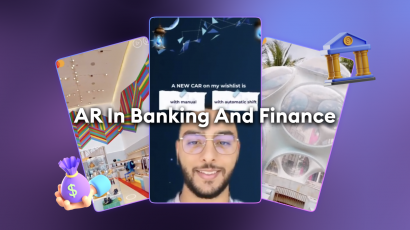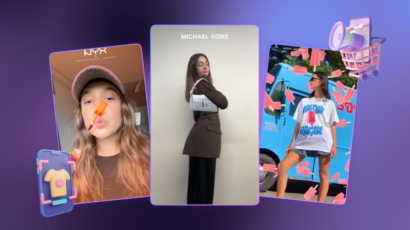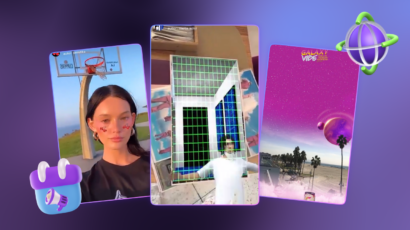As technology advances, businesses are constantly seeking new strategies to attract and retain customers. Augmented reality (AR) marketing is one of the most fascinating contemporary breakthroughs, and it has huge promise for the financial and banking sector. By utilizing AR technology, financial institutions may provide customers with distinctive and captivating experiences that raise brand awareness, enhance the user experience, and draw in new clients.

The banking and financial services sector has a number of challenges that AR marketing can assist with. The necessity to set oneself apart from rivals is a significant problem. Finding strategies to stand out is essential because there are so many financial institutions offering comparable goods and services. Financial institutions may stand out from their rivals by using AR marketing, which offers a distinctive and cutting-edge way to engage clients.
The requirement to enhance customer experience represents another pain point. The complexity of traditional financial goods and services can make it challenging for users to comprehend and use them. Customers can better comprehend financial products and services by using AR marketing to deliver more context and information in an interactive and engaging way.
Utilizing AR marketing, financial institutions may improve client connection and offer dynamic, immersive experiences. Customers can access more information, and interact with 3D models by scanning promotional materials or products, which can help them understand the product better. Complex financial goods can be made simpler through the better user experience provided by AR marketing, making it simpler for clients to understand and make informed decisions.
Boosting Brand Awareness with Playful Face Filter Quiz
An outstanding illustration of how creative and interactive marketing techniques can handle problems in the financial services sector is the case of Abu Dhabi Islamic Bank. The bank was able to generate new leads and raise brand awareness by using a Face Filter Quiz to improve ad recall among potential car loan consumers.
The Instant Experience questioned participants about the car of their dreams with an AR filter. They might swipe up to a lead form for vehicle loan inquiries after passing the quiz to enter their contact information.
The necessity to produce fresh leads was one of the main problems that this instance addressed. The Face Filter Quiz gave the bank a fun and interesting way to draw potential clients and entice them to find out more about the vehicle loan products the bank offers. The bank was able to grow its customer base as a result, which ultimately led to the generation of new leads.
The Face Filter Quiz contributed to the bank’s brand recognition in addition to producing new leads. The bank was able to set itself out from other brands and draw in new consumers by utilizing a fun and interactive style. In the end, this contributed to the bank’s increased visibility and improved brand recognition.
Overall, with a 9.3-point rise in ad recall and a 1.6-point increase in unaided ad recall, the data speak for themselves. This demonstrates how AR is effective in addressing problems in the financial services sector and boosting engagement with potential clients.
Raising ad recall with a luxury AR portal experience
American Express Australia utilized Augmented Reality (AR) technology to address a pain point in the finance sector and achieved remarkable results. Their AR campaign showcased a luxury hotel experience through an immersive AR filter, effectively communicating the exclusive benefits of their Platinum Card. The campaign resulted in a 6.6-point lift in ad recall, a 4.2-point lift in message agreement, and a 3.5-point lift in action intent. By leveraging AR, American Express Australia successfully engaged customers, enhanced brand awareness, and drove desired actions in a competitive market.
Reaching a New Audience with AR Lenses

Financial organizations can use cutting-edge technologies to solve problems with their marketing campaigns, as demonstrated by the example of Starling Bank. The bank was able to provide a distinctive and interesting experience for potential clients by utilizing Snapchat’s AR Lens, thereby increasing brand and ad recognition.
One of the major pain points addressed in this case was the need to acquire new users. By using Snapchat’s AR Lens, Starling Bank was able to reach a younger audience who are more likely to engage with AR experiences. This helped to attract new users and expand the bank’s customer base.
The AR Lens not only attracted new users but also increased bank brand recognition. The bank succeeded in making a memorable and unique experience that set its brand apart from rivals by including a murmuration of starlings around the user’s head and the sky. In the end, this contributed to the bank’s increased visibility and improved brand recognition.
The numbers show how well the AR Lens works to address problems in the financial services sector. The campaign was a huge success, with a 61% lower cost per install than other platforms, a 7-point boost in brand recognition, and a 12-point increase in ad awareness. This emphasizes how critical it is to make use of cutting-edge technologies to give potential customers engaging and memorable marketing experiences.
Improving Client Experiences and Brand Loyalty with Immersive AR Tours
An excellent illustration of how financial services organizations may employ AR technology to improve client experiences, boost user engagement, and provide cardholders unique access is the cooperation between Mastercard and the Miami Design District.
Mastercard was able to give cardholders a unique and immersive experience by delivering an AR tour of seven significant works of art in the area. This not only improves the client experience but also encourages cardholders to feel more loyal.
Additionally, viewers of the AR tour can view the artwork in 360 degrees from the comfort of their own homes. As a result, cardholders may still take advantage of exclusive opportunities and interact with the Mastercard brand without ever leaving their homes.
Overall, Mastercard’s collaboration with the Miami Design District shows how financial services businesses can use AR technology to develop one-of-a-kind, engaging experiences for their clients while also addressing pain points like improving the client experience, raising user engagement, and giving cardholders exclusive access.
The Power of AR Marketing Changing the Game
The financial services and banking sector has many prospects thanks to AR marketing. Financial institutions may stand out from their rivals, enhance the consumer experience, offer more context and details about offerings, and draw in new clients by utilizing AR technology. AR marketing aids in addressing the industry’s problems.
Financial services and banking organizations that implement AR marketing are likely to have a competitive edge given the rising adoption of AR technology and the rising expectations of consumers for immersive experiences.
Take the first step towards unlocking the full potential of AR by incorporating it into your marketing. AR has something to offer everyone, so don’t pass up this revolutionary technology and schedule a quick consultation with us for more insights.







